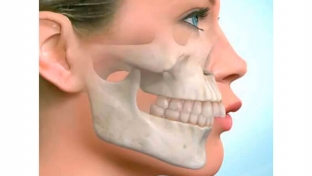One of the options for malocclusion is the distal bite. This type of bite develops when the lower dentition moves back in relation to the upper one. This violates the lateral relationship of the teeth in the sagittal direction and incisal disocclusion. Among all dentoalveolar anomalies, distal occlusion is 30%. In dentistry, the distal occlusion is also called "prognathic occlusion", "posterior occlusion" or "prognathia." Read more about the causes of development and clinical manifestations of distal occlusion in our article.
Causes and factors contributing to the formation of distal occlusion
At birth, the lower jaw is in a distal position in relation to to the upper jaw. As a result, a sagittal gap is formed between the jaws. Over time, in the process of teething, breastfeeding and the development of chewing function, the jaws gradually align. Thus, an orthognathic occlusion is formed from the distal occlusion.
The main reason for the formation of distal occlusion is artificial feeding, because it does not require any effort from the child.
Malocclusion is detected in half of children with rickets and in a third of children with nasal breathing disorders. Read more about the manifestations of distal occlusion on estet-portal.com. Bad habits such as thumb sucking, pacifiers, and lip biting increase the risk of underbite. The lack of fluorine and calcium in the body, the lack of solid food in the diet at a certain stage of growing up contribute to the development of malocclusion.
Clinical manifestations of distal occlusion
Manifestations of distal occlusion can be conditionally divided into oral and facial. The distal bite changes the proportions and profile of the face due to the protrusion of the upper jaw, incomplete development of the chin. In this case, the patient's face acquires a "bird-like appearance", as with a deep bite. In a patient with an overbite, the mouth is slightly open, the chin fold is very pronounced, the lips do not close.

Distal occlusion impairs the patient's quality of life with functional impairment. We are talking about difficulty in biting and chewing food, the presence of constant pain in the temporal – mandibular joint, impaired nasal breathing. This bite also negatively affects the appearance of the patient.
In the presence of an overbite, the patient has an increased risk of developing caries, TMJ dysfunction and periodontal pathologies.
Three oral signs of overbite:
- the upper and lower incisors do not meet, and a sagittal gap forms between them;
- upper anterior teeth protruding;
- the mutual arrangement of the lateral teeth is broken.
Diagnosis and treatment of distal occlusion in a patient
The orthodontist can determine the presence of distal occlusion already at the meeting with the patient. A clinical examination is carried out in order to determine the size of the jaws, the presence of a sagittal fissure, the relative position of the dentition, the shape of the alveolar process and the jaws.
For the purpose of differential diagnosis, teleradiography is performed, followed by calculation and analysis of indicators, and constructive occlusion is determined. Against the background of these measurements, diagnostic models of the jaws are made and examined.
Correction of the overbite should begin even before the period of replacement of milk teeth with permanent teeth. Treatment of underbite is aimed at restraining the growth of the upper jaw and stimulating the development of the lower jaw. This is done using removable orthodontic appliances. During the period of change of occlusion, the main goal of therapy for distal occlusion is the correction of dental arches and forms. For this, removable plate devices are used. After the completion of jaw growth, distal occlusion treatment is carried out with the help of bracket – system.







Add a comment